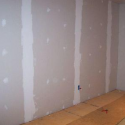Here in the Chicago, area we are lucky to have real seasonal changes—we’ve got that summer sunshine, golden leaves in the autumn, winter snows, and spring showers. Unfortunately, that can also cause your plaster and drywall to expand and contract as the temperatures fluctuate, and at some point you’ve likely seen the surface of the wall crack with those pressures. Any time you’re faced with a problem like plaster and drywall cracks, there are two ways you can fix it: you can either patch over the issue and keep scraping by at the status quo, or you can take the extra effort to solve the problem for good.
A lot of painting companies—and even some homeowners—are okay with a paint job that merely covers the wall. On the other hand, here at Nolan Painting, if we’re going to paint your home, we’re not just going to cover your walls. We’re going to do whatever it takes to get the room looking smooth, seamless, and professional. Before you can see that kind of final result, you’ve got to perfect the surface of the walls. If you’re seeing cracks or nail pops in your plaster and drywall, taking the time to repair the surface before you begin to paint will make for a vastly superior final finish.
Plaster Cracks
Homeowners are generally going to notice two types of cracks in plaster walls: hairline cracks (those thin, spidery cracks) and structural cracks (wider rifts that usually split near window sills or door frames). If you’re seeing hairline cracks, there’s a pretty quick fix for that. Nolan’s team will run a coat of spackle over the crack and feather-sand it. Structural cracks, on the other hand, tend to come back very quickly with a spackle fix. For structural cracks, we’ll cut open the rift and clean it, then patch and fill it. After that, we run a two-inch fiberglass mesh over the expanse of the crack. The fiberglass mesh makes a tear-resistant surface, which we spackle and feather-sand.
Drywall Issues: Seam Failures and Nail Pops
Drywall is where you’re going to see those nail pops that come from the expansion and contraction of your building materials. The motion of the walls will wiggle the nails until they pop out, punching through the top layer. To repair a nail pop, we make sure that the drywall is fastened properly, then patch over the area for smoothness.
With drywall, you can also see the seams begin to fail over time. The same motion that causes the nail pops can cause the drywall tape to crack, and your individual sheets of drywall will start to separate. To fix a failing seam, we’ll re-seam it with new tape and spackle it smooth. It’s much more effective to just create an entirely new seam than to try to patch over splitting tape.
A Smooth Surface Makes for a Quality Paint Job
As the saying goes, if a job’s worth doing, it’s worth doing it right. If you’re planning a renovation for your home, make sure that your walls are getting the star treatment they deserve. Almost every wall needs a little TLC before you start to paint, even if it’s just repairing a crack or a few nail pops. There’s no point in throwing a coat of paint over a problematic wall and calling it good.
